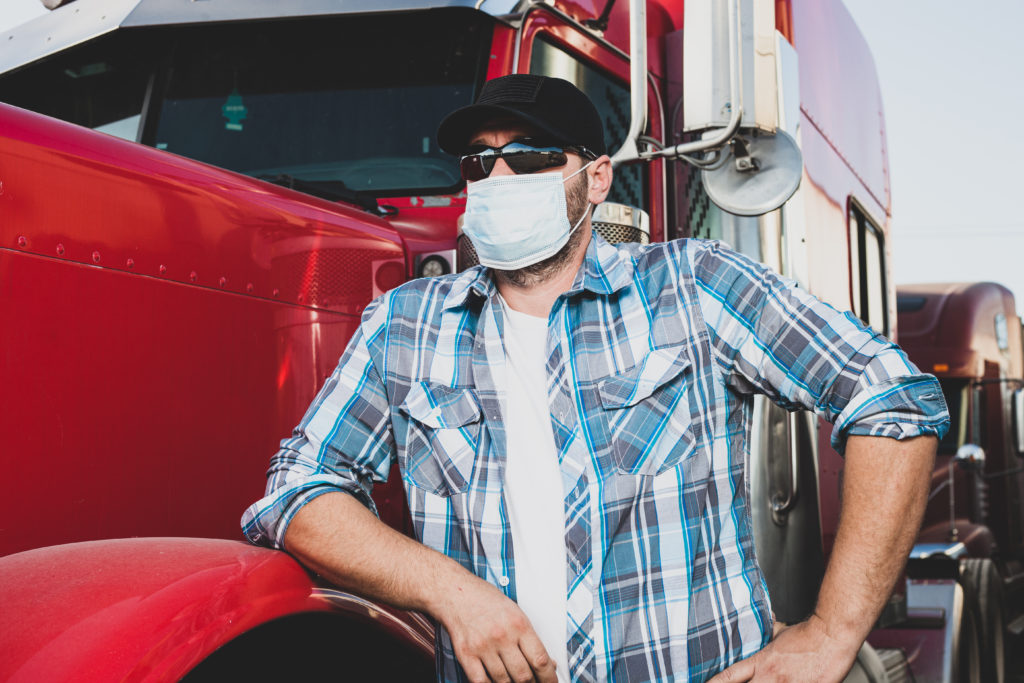
As coronavirus continues affecting the nation, truckers have had to implement new sanitation and social distancing techniques into their daily lives. Now, it is the new normal for the industry.
According to the CDC, truckers must: always keep a distance of 6 feet away from anyone else whenever possible; limit outside-of-cab time while fueling, loading, unloading, and when at truck stops; use paperless invoicing; make appointments with facilities ahead of unloading activities; communicate with dock managers via phone; pack food and water to limit the number of stops on the road; avoid shaking hands; and keep trucks well-ventilated.
The CDC also wants truck drivers to continue wearing cloth face coverings whenever they may be in a public area, as well as to regularly clean and disinfect surfaces such as: the truck cab, including door handles, the steering wheel, seat belts, arm and head rests, the turn signal, wiper controls, the dashboard, and temperature controls; the sleeper berth, including light switches, the mattress tray, and other flat surfaces. They must also always request anyone else using the truck thoroughly disinfects it before returning it back and that all disinfection routines include diluted household bleach solutions or alcohol solutions with at least 70% alcohol.
Although these guidelines are appreciated and understood, adhering to them hasn’t been so simple, as many of these necessary materials have been scarce, even for the trucking industry. To keep risk to a minimum as truckers serve areas of the country with the highest numbers of COVID-19 cases, the industry has had to find new and creative ways to keep its employees safe.
For example, Grand Island Express has had a particularly difficult time finding cleaning supplies and personal protective gear. The company had to use extra T-shirts found in storage to make masks and also had to source cleaning products from a restaurant supplier connection.
“It is forcing us to think outside of the box,” said Grand Island director of operations, Deen Albert.
One driver for the company, Josh Rodriguez, said even these unorthodox provisions have helped him feel safer when heading into areas with heavy virus numbers. Rodriguez wears a mask, gloves, and keeps hand sanitizer ready at all times.
“I feel as safe as I can in this situation with the interactions we have,” he said. “I don’t want to drive myself crazy, but I want to balance it with the proper precautions.”
Still, other fleets are struggling to find necessary protective supplies as well. C.R. England’s director of management series, David Allred, said his fleet has had to find loopholes in obtaining effective hand sanitizer.
“We had to get creative,” he said, “such as using a four-ounce restaurant squeeze bottle for hand sanitizer.” C.R. England is also still working to find enough masks and gloves for all employees.
“However, since bulk orders have been back-ordered for some time, we still encourage all our employees to take the initiative to secure these items for themselves first, and the company will provide supplemental support,” he explained.
Because of that, C.R. England driver and trainer John Goode has relied on family for sanitation supply help. His aunt is a dentist, so she was able to give him much-needed gloves and masks once her practice shutdown during the pandemic.
“Every time we leave the truck, we put our surgical gloves on and put our mask on, and we don’t bring the gloves back in the truck with us,” said Goode. “After we do that, we sanitize our hands with the hand sanitizer, and we take the Clorox wipes and wipe down everything.”
Social distancing has had to become routine, as well, although it is not always easy in this industry.
“On the road, many shippers are not allowing drivers to access their docks,” said Averitt Express president Wayne Spain. “When they do have access to the dock and need to interact with a customer, they are keeping adequate space in between one another.”
Over-the-road Averitt driver Chris Yohn said customer locations are working to take initiative on social distancing.
“Shippers and receivers are doing their best to keep everyone separated,” he said.
These measures are even implemented when paperwork and signatures are needed.
“When it comes to paperwork, I’ll place the forms on a table for [the customer] to initial so that we can keep an appropriate distance from each other,” another Averitt driver, Manny Rodriguez, explained.
Grand Island’s Rodriguez also said customers have been marking 6 feet distances to create easier separation between themselves and drivers.
“They’ve been enforcing that,” he said. “Before, you’d be standing in line with eight to 10 drivers. Now, there are no more than three inside, and the rest wait outside.”
Reader Interactions